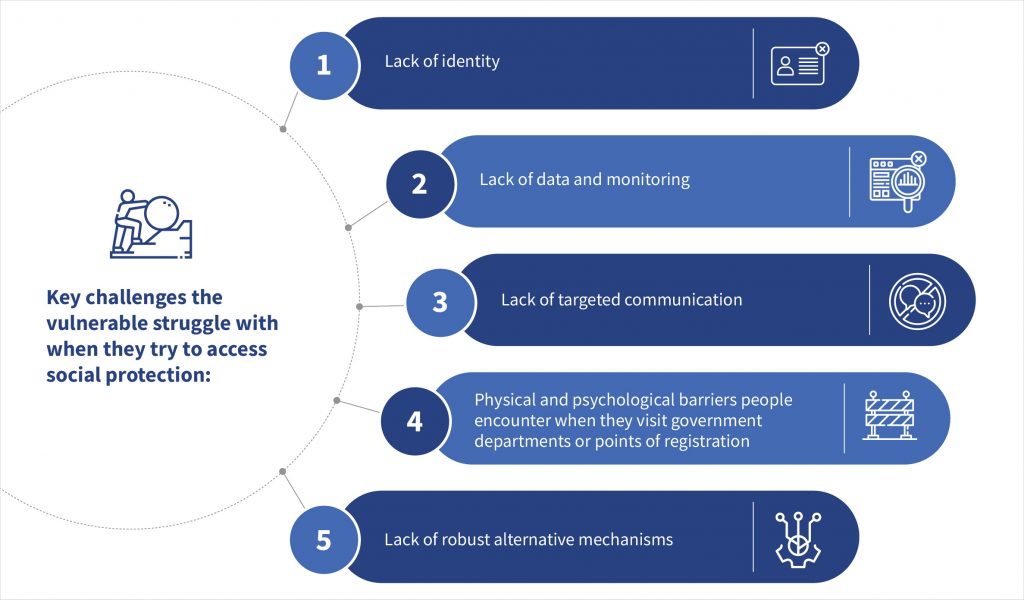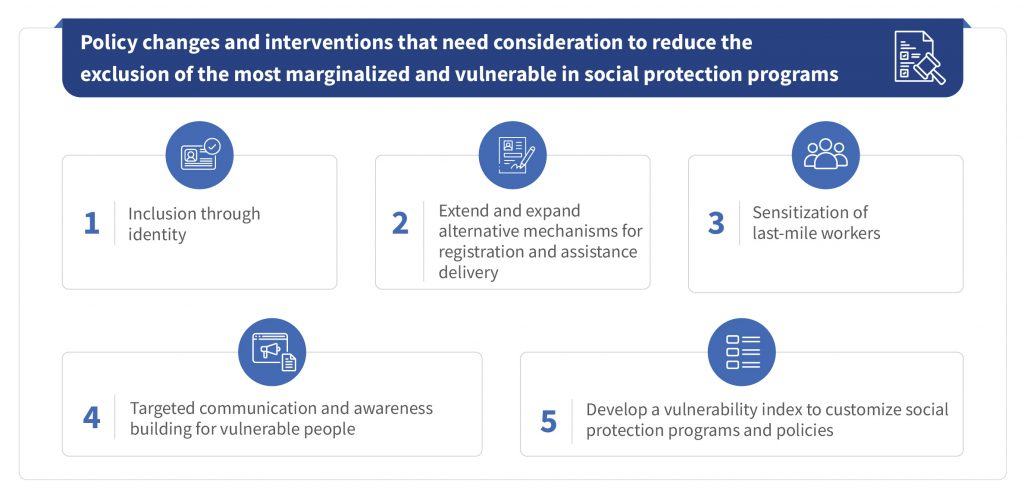Inclusive Social Protection: Mitigating Exclusion of Vulnerable Populations
by Arshi Aadil
Jun 8, 2023
6 min
Homeless individuals, differently-abled people, transgender communities, indigenous populations, and migrants often find themselves excluded from the safety net social protection programs provide. The blog highlights numerous barriers that contribute to the exclusion of vulnerable populations from accessing social protection benefits. Additionally, it provides recommendations to establish an inclusive safety net for all vulnerable populations
In a world striving for a brighter future, where no one is left behind, access to social protection becomes a crucial lifeline. It serves as the key that unlocks the doors to ending poverty, achieving universal health coverage, and reducing inequality by 2030, as outlined in the Sustainable Development Goals (SDGs).
Governments and regulators worldwide have recognized the power of social protection programs (SPPs) as instruments to uplift impoverished populations and combat the effects of inequality. Governments worldwide have planned or implemented more than 1,100 social protection programs, which cumulatively benefit more than 1.8 billion people who have been ravaged by COVID-19.
However, even with these efforts, the most vulnerable groups still remain overlooked. Homeless individuals, differently-abled people, transgender communities, indigenous populations, and migrants often find themselves excluded from the safety net these programs should provide. Shockingly, only one in three people with severe disabilities worldwide receive disability benefits, and a mere 23% of migrants possess any form of social security documentation. Clearly, these vulnerable groups, especially women, are in dire need of social protection payments.
This blog is an attempt to shed light on the major challenges these marginalized populations face when accessing social protection programs in developing countries, such as India, Indonesia, and Bangladesh. Read on to explore recommendations to address these obstacles and design targeted interventions that ensure social protection becomes a reality for those who need it most, and in the process, create a fairer, more equitable world for all.
Key challenges the vulnerable struggle with when they try to access social protection:
1. Lack of identity
A substantial hurdle vulnerable populations face is the lack of proper citizenship documents to establish their identity. These groups cannot apply for social protection benefits without formal identity proof. For instance, the 2019 State of Aadhaar report found that 27% of transgender people in India lack an Aadhaar (digital identity). This is problematic for a country that otherwise succeeded in expanding Aadhaar, as around 99.9% of residents have an Aadhaar card. Similarly, discrimination against transgender people is prevalent in Indonesia, as they are often excluded[1] from government safety net programs due to a lack of national identity (KTP).[2]
Other vulnerable groups, such as homeless people, have the most acute need for food security, health, and shelter assistance. Yet they are excluded from their entitlement as they lack identity documents. When subsidized or free services, such as basic education, health, and food security are offered only after the identity verification of individuals, it is a worrying aspect that the majority of the most excluded and marginalized still face bottlenecks in establishing their identity.
2. Lack of data and monitoring
Without identity documents, any credible data on vulnerable groups and monitoring their inclusion in social protection programs proves challenging. Many governments in developing countries, including India, Indonesia, and Bangladesh, have created social registries to automatically include the targeted population groups in the social protection programs. However, the most excluded groups remain outside these databases and must visit the government offices several times to register for a new program.
3. Lack of targeted communication
Communication on various programs and policies available for vulnerable groups is weak and poorly targeted. Most governments do not direct or customize awareness-building efforts for vulnerable communities, which leads to exclusion and reduced opportunities for direct engagements with the government. In particular, indigenous groups, differently-abled people, migrants, and homeless people are more susceptible to missing out on critical information on the social assistance they are eligible to receive.
People from these vulnerable groups often lack access to communication mediums, such as television, radio, internet, and phones, which further deprives them of information from the government. For instance, despite a robust social assistance package announced by the Indian government during the COVID-19 outbreak, the 1.7 million homeless people in India faced significant challenges in receiving them. Ironically, states with 60% of India’s homeless population did not even announcing the relief measures.
4. Physical and psychological barriers people encounter when they visit government departments or points of registration
Vulnerable communities, such as transgender people, often face exclusion and harassment from society, which compels them to shy from government offices. The last-mile workers at public offices and financial institutions are not sensitized to deal with such vulnerable groups, which often leads to their mistreatment.
A study conducted by the Indonesian Puzzle Community with transgender people in 2020 revealed 84.2% of respondents had a poor experience accessing public services as they lacked ID cards. People from such groups also struggle with barriers related to culture, norms, fear, and geographical location that further restrict their access to SPPs.
5. Lack of robust alternative mechanisms
Governments have created alternative solutions for vulnerable people to ensure they do not miss their entitlements even when they fail to meet the documentation-related conditions. However, the design of such alternative mechanisms often fails to address fundamental issues.
For instance, as part of their thrust on digitization, most governments in developing countries extend social protection by transferring cash into bank accounts or mobile money wallets. However, homeless people and tribal groups are excluded as they largely lack accounts or wallets. During the COVID-19 outbreak, the Indian and Bangladeshi governments announced cash assistance. Yet these did not reach homeless people because they lacked bank accounts.
Policy changes and interventions that need consideration to reduce the exclusion of the most marginalized and vulnerable in social protection programs
Developing countries have distinct national experiences regarding vulnerable populations and related laws and guidelines. They could consider developing customized interventions based on the following strategies and approaches.
1. Inclusion through identity
First, governments should ensure a foundational identity for the most vulnerable to roll out specific measures to bridge the last-mile gap in social protection for them. Micro-surveys, proofing through community workers, the local police, NGOs, and alternative mechanisms that permit registrations without birth certificates would open access to public services for vulnerable populations.
Further, vulnerable populations, such as homeless people and migrants, risk losing their documents as they lack a permanent place of residence. Governments should explore new technology approaches, such as decentralized identity systems, for easier recording and authentication of vulnerable groups.
2. Extend and expand alternative mechanisms for registration and assistance delivery
Vulnerable populations need flexibility in how they submit their documents and receive assistance. For such people, governments should allow flexibility to permit expanded, alternative options for them to prove their identity and eligibility. For instance, many states in India now provide doorstep assistance to differently-abled people, while Bangladesh has eased certain rules on providing identity to orphans.
3. Sensitization of last-mile workers
Last-mile workers include government officials and bank agents. They need to be sensitized to treat all applicants without bias against their gender, identity, income, or residential status. This can reduce the social stigma, fear, and resistance of vulnerable communities when they visit public offices. Such sensitization measures will further increase the interaction of such communities with the government, leading to better data collection and monitoring to expand social protection entitlements to the vulnerable communities
4. Targeted communication and awareness building for vulnerable people
Governments should adopt a bottom-up, community-based approach to deliver messages to vulnerable communities. Frontline workers, NGOs, community leaders, and labor associations should work to build awareness of the available assistance, entitlements, and rights of vulnerable and marginalized groups.
5. Develop a vulnerability index to customize social protection programs and policies
SPPs cannot be designed using a “one-size-fits-all” approach. Some population groups are more vulnerable than others. For instance, communities in Indonesia are prone to tsunamis, earthquakes, and volcanic eruptions that destroy homes and communities. The governments should develop a vulnerability index based on demographical, occupational, and climatic patterns to identify the most vulnerable people. For instance, governments should prioritize and include in the safety net ecosystem populations with disabilities, displaced people or those on the brink of losing shelter, people from highly remote areas, or people who live in disaster-prone areas.
Developing countries must take specific measures to build and strengthen their existing institutional structures to develop targeted policies for vulnerable populations. A focused approach will plug current gaps in accessing inclusive social protection and extend coverage of the vulnerable in the social protection system substantially by 2030.
[1] https://en.tempo.co/read/1468430/e-ktp-for-transgender-suara-kita-hopes-for-more-accessible-public-services
[2] https://en.tempo.co/read/1468430/e-ktp-for-transgender-suara-kita-hopes-for-more-accessible-public-services
Written by

 by
by  Jun 8, 2023
Jun 8, 2023 6 min
6 min

Leave comments